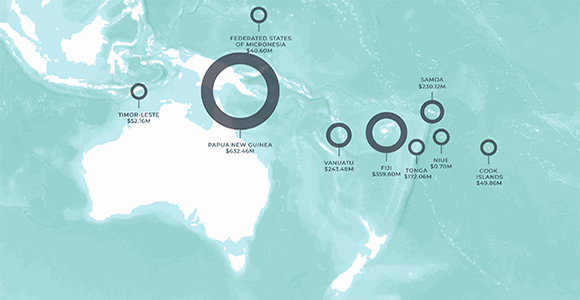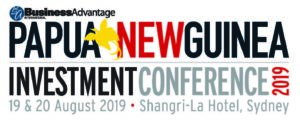During a visit to the Solomon Islands last month, Australia’s Prime Minister, Scott Morrison, announced a 10-year AUD$250 million (K582 million) package for infrastructure. Kevin McQuillan explores Australia’s Pacific ‘Step Up’ policy.

China has diplomatic relations with 8 Pacific island countries: the Cook Islands, Federated States of Micronesia (FSM), Fiji, Niue, Papua New Guinea (PNG), Samoa, Tonga, and Vanuatu. China has contributed more than US$1,781 million to the Pacific regions.
Speaking at the ANU’s State of the Pacific Conference last September, Australian Foreign Minister Marise Payne said: ‘Stepping up in the Pacific is not an option for Australian foreign policy—it is an imperative’.
The Pacific is caught up in a geopolitical struggle between China on one hand and the United States along with Australia, New Zealand and Japan on the other, according to Lowy Institute Pacific Analyst, Jonathan Pryke.
The Lowy Institute estimates that since 2006, China has been increasing its economic involvement in the region, providing more than AUD$2.3 billion (K5.36 billion), mainly in concessional loans, and signing up nations (including PNG) to its Belt and Road Initiative.
Australia is still the region’s largest aid donor, contributing more than three-quarters of total aid and loans compared to China’s 14 per cent. It is mostly directed to improving corporate governance, while Beijing has focused on infrastructure and major works.
Hugh White, a professor of strategic studies at the Australian National University (ANU) in Canberra, told Bloomberg ‘there’s no doubt’ China could seek to establish a military presence in the Pacific in the future, cashing in its influence with ‘one of these small, vulnerable states’.
‘It intends to become the primary power in east Asia and the western Pacific,’ White said.
‘It’s almost like there’s going to be a new iron curtain dropping across parts of the Pacific and it’s going to be a technology curtain, not a physical curtain like it was in Europe—and PNG is going to have a foot in both worlds.’
NZ Foreign Minister, Winston Peters, acknowledged the changing geopolitical landscape, telling the Lowy Institute: ‘But the Pacific overall has also become an increasingly contested strategic space, no longer neglected by great power ambition, and so Pacific Island leaders have more options. This is creating a degree of strategic anxiety.’
Stepping up: infrastructure
Among Australia’s Step Up measures are two major infrastructure initiatives, a A$2 billion (K4.66 billion) finance facility, and an expanded export finance and insurance corporation. But five new diplomatic missions are also being opened in the Pacific. A joint Australia, New Zealand, US and Japan plan seeks to provide access to electricity for 70 per cent of Papua New Guinea by 2030.
In addition, Australia’s Pacific Labour Mobility Scheme is being expanded and a new Australia Pacific Security College will be established; the US will partner with Australia and Papua New Guinea to upgrade the Lombrum naval base in PNG, which has a strategically vital position overlooking key trade routes.
In the Solomon Islands, Prime Minister Manasseh Sogavare is coming under increasing pressure to switch the country’s political allegiance to China from Taiwan, which provides the Solomon Islands with many millions of dollars in aid every year.
When asked if the US was engaging with the Solomon Islands on the Taiwan issue, a spokeswoman for the State Department said: ‘The United States opposes unilateral actions by any party aimed at altering the status quo’.
The role of China’s Huawei, the world’s largest telecommunications equipment, and China’s Belt and Road initiative, are two issues that are in dispute between China and the US.
In June, 2018, at the urging of the US, Australia stepped in to fund an undersea cable link between Sydney, Honiara and Port Moresby, which was originally to be built by China’s Huawei.
‘If the West wants countries such as PNG to not partner with China on critical infrastructure or other deals, they have to provide better options, better alternatives.’
PNG announced it would honour its agreement with Huawei to build the country’s domestic internet infrastructure.
‘It’s a delicate thing dealing with these large geopolitical blocs,’ says tech entrepreneur and futurist Mark Pesce. ‘It’s almost like there’s going to be a new iron curtain dropping across parts of the Pacific and it’s going to be a technology curtain, not a physical curtain like it was in Europe—and PNG is going to have a foot in both worlds.’
Pryke rejects the need for Pacific nations to ‘take a position in this geopolitical struggle’.
‘If the US really does want to try and push China then they’re going to fail. China is deeply, deeply embedded into the Pacific region and we’re all going to have to learn to play together in the long-term interests of PNG.
‘If the West wants countries such as PNG to not partner with China on critical infrastructure or other deals, they have to provide better options, better alternatives.’
Pesce agrees. ‘At one level, it’s stuck in the middle and at another level it gets to play both sides against one another so the clever political stance is probably to be as friendly to everybody as absolutely you can be without angering anyone.’
 Futurist Mark Pesce will be speaking at the 2019 Papua New Guinea Investment Conference at the Shangri-La Hotel, Sydney on 19 and 20 August.
Futurist Mark Pesce will be speaking at the 2019 Papua New Guinea Investment Conference at the Shangri-La Hotel, Sydney on 19 and 20 August.










Speak Your Mind